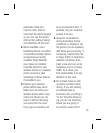34
FDA web page on wireless
phones
(http://www.fda.gov/cdrh/
phones/index.html)
Federal Communications
Commission (FCC) RF Safety
Program
(http://www.fcc.gov/oet/
rfsafety)
International Commission
on Non-lonizing Radiation
Protection
(http://www.icnirp.de)
World Health Organization
(WHO) International EMF
Project
(http://www.who.int/emf)
National Radiological
Protection Board (UK)
(http://www.nrpb.org.uk/)
10 Driver Safety Tips
Your wireless phone gives
you the powerful ability
to communicate by voice
almost anywhere, anytime.
An important responsibility
accompanies the benefi ts
of wireless phones, one that
every user must uphold.
When operating a car, driving
is your fi rst responsibility.
When using your wireless
phone behind the wheel of a
car, practice good common
sense and remember the
following tips:
1. Get to know your wireless
phone and its features
such as speed dial and
redial. Carefully read your
instruction manual and
learn to take advantage
of valuable features most
phones offer, including
Guidelines for safe and effi cient use


















